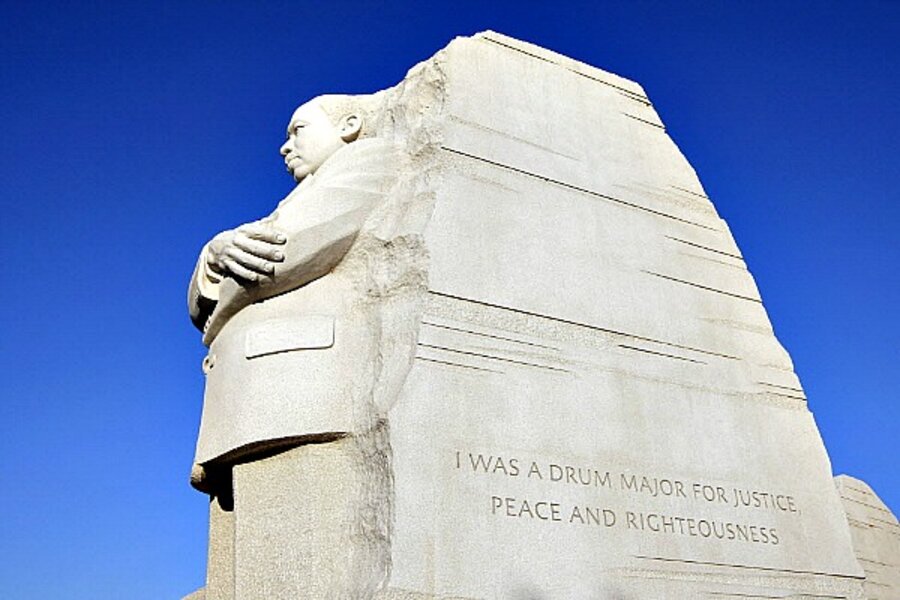Does memorial quote make Martin Luther King Jr. seem like an 'arrogant twit?'
Loading...
Public art is inevitably controversial, especially if it’s political. Think of the Vietnam Veterans Memorial created in 1982. Called “a black gash of earth” by its critics, it’s now the most-visited site in Washington.
The same is true of the new Martin Luther King Jr. Memorial, a tribute to the preeminent icon of civil rights – a political issue if ever there was one.
Just ask poet and author Maya Angelou.
Ms. Angelou, herself a civil rights activist and a literary icon with 30-plus honorary degrees and the Presidential Medal of Freedom, says the new memorial – at least one engraved quote prominently attributed to Dr. King – makes him look like “an arrogant twit.”
Influential poets, it seems, would rather you keep your hands off the verbiage – especially words from one known for his stirring, historic rhetoric.
Angelou is dismayed at a design change that meant truncating something King had said to the congregation at the Ebenezer Baptist Church in Atlanta two months before he was assassinated in 1968 into a sound bite so it could fit a particular space on the granite memorial.
You be the judge.
Full quote: “If you want to say that I was a drum major, say that I was a drum major for justice. Say that I was a drum major for peace. I was a drum major for righteousness. And all of the other shallow things will not matter. I won't have any money to leave behind. I won't have the fine and luxurious things of life to leave behind. But I just want to leave a committed life behind.”
As engraved: “I was a drum major for justice, peace and righteousness.”
It was the editorial excision of that small but mighty “if” that did it for Angelou.
“The quote makes Dr. Martin Luther King look like an arrogant twit,” she told the Washington Post.
“He had no arrogance at all. He had a humility that comes from deep inside,” she said. “The ‘if’ clause that is left out is salient. Leaving it out changes the meaning completely.”
The paraphrase “minimizes the man,” she said. “It makes him seem less than the humanitarian he was…. It makes him seem an egotist.”
Monument designers shortened that quote when they decided to change the placement of two inscriptions so that one – “Out of the mountain of despair, a stone of hope.” – would be more prominent.
“As you move through the process, things happen and you have to make design changes on the spot,” Ed Jackson Jr., the memorial’s executive architect, told the Post. He checked with two other memorial advisors who were okay with the change.
“Now, did I ask Maya Angelou?” he said. “No.”
Others have criticized the memorial for different reasons.
In his review in the New York Times, Edward Rothstein described “these mounds of granite” as having “an almost artificial appearance with their sketchy, cartoonish contours.”
“The mound’s isolation from any other tall objects, its enormity and Dr. King’s posture all conspire to make him seem an authoritarian figure, emerging full-grown from the rock’s chiseled surface, at one with the ancient forces of nature, seeming to claim their authority as his,” Mr. Rothstein writes.
If you see it that way, it’s not exactly the image most people have of King, whose model for action was the nonviolent “soul force” of Mohandas K. Gandhi.
Probably like Gandhi, “Dr. King would not have wanted to have a monument to himself at all,” Mr. Jackson, the memorial’s executive architect,” told NPR this week.
“But we're not building this for Dr. King,” he said. “We're building this in honor of his legacy such that his legacy doesn't die with him. And so we're building this to inspire others to follow in his footsteps and in doing so you have to do it in such a compelling way that people are moved emotionally.”
So far, judging by the discussion the memorial has generated and the crowds it’s attracted, it seems to have been a success.
Maya Angelou has written a poem “Abundant Hope” for the dedication of the Martin Luther King Jr. memorial, which was delayed due to hurricane Irene.
Read it here and hear the poet recite it here. Its art is in words, not granite. But "Abundant Hope" is monumental nonetheless, and every word counts.





